Spatial and Temporal Variations in the Extent and Thickness of Arctic Landfast Ice
Abstract
:1. Introduction
2. Study Area and Data
2.1. Study Area
2.2. Data
2.2.1. Landfast Ice Extent Dataset
2.2.2. Landfast Ice Thickness Dataset
2.2.3. ECMWF Air Temperature Reanalysis
3. Results
3.1. Landfast Ice Extent
3.2. Regional Landfast Ice
3.3. Landfast Ice Duration
3.4. Landfast Ice Thickness
3.5. Stefan’s Law Calculation
4. Discussion
4.1. Uncertainty in the Landfast Ice Extent
4.2. Uncertainty in the Landfast Ice Thickness
4.3. Relationship of Extent and Thickness Trends
5. Conclusions
Author Contributions
Funding
Acknowledgments
Conflicts of Interest
References
- Laxon, S.W.; Giles, K.A.; Ridout, A.L.; Wingham, D.J.; Willatt, R.; Cullen, R.; Kwok, R.; Schweiger, A.; Zhang, J.L.; Haas, C.; et al. CryoSat-2 estimates of Arctic sea ice thickness and volume. Geophys. Res. Lett. 2013, 40, 732–737. [Google Scholar] [CrossRef] [Green Version]
- Zhang, X.; Walsh, J.E. Toward a seasonally ice-covered Arctic Ocean: Scenarios from the IPCC AR4 model simulations. J. Clim. 2006, 19, 1730–1747. [Google Scholar] [CrossRef]
- Pachauri, R.K.; Allen, M.R.; Barros, V.R.; Broome, J.; Cramer, W.; Christ, R.; Church, J.A.; Clarke, L.; Dahe, Q.; Dasgupta, P.; et al. Climate Change 2014: Synthesis Report. Contribution of Working Groups I, II and III to the fifth Assessment Report of the Intergovernmental Panel on Climate Change; Pachaurl, R., Meyer, L., Eds.; IPCC: Geneva, Switzerland, 2014; p. 151. ISBN 978-92-9169-143-2. [Google Scholar]
- Serreze, M.C.; Barrett, A.P.; Stroeve, J.C.; Kindig, D.N.; Holland, M.M. The emergence of surface-based Arctic amplification. Cryosphere 2009, 3, 11–19. [Google Scholar] [CrossRef] [Green Version]
- Cohen, J.; Screen, J.A.; Furtado, J.C.; Barlow, M.; Whittleston, D.; Coumou, D.; Francis, J.; Dethloff, K.; Entakhabi, D.; Overland, J.; et al. Recent Arctic amplification and extreme mid-latitude weather. Nat. Geosci. 2014, 7, 627. [Google Scholar] [CrossRef] [Green Version]
- Screen, J.A.; Simmonds, I. The central role of diminishing sea ice in recent Arctic temperature amplification. Nature 2010, 464, 1334. [Google Scholar] [CrossRef] [PubMed] [Green Version]
- Perovich, D.K.; Grenfell, T.C.; Richter-Menge, J.A.; Light, B.; Tucker, W.B.; Eicken, H. Thin and thinner: Sea ice mass balance measurements during SHEBA. J. Geophys. Res. Ocean. 2003, 108, 8050. [Google Scholar] [CrossRef]
- Lei, R.; Xie, H.; Wang, J.; Leppäranta, M.; Jónsdóttir, I.; Zhang, Z. Changes in sea ice conditions along the Arctic Northeast Passage from 1979 to 2012. Cold Reg. Sci. Technol. 2015, 119, 132–144. [Google Scholar] [CrossRef]
- Maslanik, J.; Stroeve, J.; Fowler, C.; Emery, W. Distribution and trends in Arctic sea ice age through spring 2011. Geophys. Res. Lett. 2011, 38, L13502. [Google Scholar] [CrossRef]
- Cavalieri, D.J.; Parkinson, C.L. Arctic sea ice variability and trends, 1979–2010. Cryosphere 2012, 6, 881. [Google Scholar] [CrossRef] [Green Version]
- Polyakov, I.V.; Walsh, J.E.; Kwok, R. Recent changes of Arctic multiyear sea ice coverage and the likely causes. Bull. Am. Meteorol. Soc. 2012, 93, 145–151. [Google Scholar] [CrossRef]
- Mahoney, A.R.; Barry, R.G.; Smolyanitsky, V.; Fetterer, F. Observed sea ice extent in the Russian Arctic, 1933–2006. J. Geophys. Res. Ocean. 2008, 113, C11005. [Google Scholar] [CrossRef] [Green Version]
- Xia, W.; Xie, H.; Ke, C. Assessing trend and variation of Arctic sea-ice extent during 1979–2012 from a latitude perspective of ice edge. Polar Res. 2014, 33, 21249. [Google Scholar] [CrossRef] [Green Version]
- Aksenov, Y.; Popova, E.E.; Yool, A.; Nurser, A.J.G.; Williams, T.D.; Bertino, L.; Bergh, J. On the future navigability of Arctic sea routes: High-resolution projections of the Arctic Ocean and sea ice. Mar. Policy 2017, 75, 300–317. [Google Scholar] [CrossRef] [Green Version]
- Overland, J.E.; Wood, K.R.; Wang, M. Warm Arctic-cold continents: Climate impacts of the newly open arctic sea. Polar Res. 2011, 30 (Suppl. 1), 1–14. [Google Scholar] [CrossRef]
- Howell, S.E.; Laliberté, F.; Kwok, R.; Derksen, C.; King, J. Landland-fast ice thickness in the Canadian Arctic Archipelago from observations and models. Cryosphere 2016, 10, 1463–1475. [Google Scholar] [CrossRef] [Green Version]
- Reimnitz, E.; Toimil, L.; Barnes, P. Arctic continental shelf morphology related to sea-ice zonation, Beaufort Sea, Alaska. Mar. Geol. 1978, 28, 179–210. [Google Scholar] [CrossRef]
- Brown, R.D.; Cote, P. Interannual variability of landland-fast ice thickness in the Canadian High Arctic, 1950–1989. Arctic 1992, 45, 273–284. [Google Scholar]
- Barry, R.G.; Moritz, R.E.; Rogers, J.C. The land-fast ice regimes of the Beaufort and Chukchi Sea coasts, Alaska. Cold Reg. Sci. Technol. 1979, 1, 129–152. [Google Scholar] [CrossRef]
- Melling, H. Sea ice of the northern Canadian Arctic Archipelago. J. Geophys. Res. Ocean. 2002, 107, 3181. [Google Scholar] [CrossRef]
- Divine, D.; Korsnes, R.; Makshtas, A. Variability and climate sensitivity of land-fast ice extent in the north-eastern Kara Sea. Polar Res. 2003, 22, 27–34. [Google Scholar] [CrossRef] [Green Version]
- Galley, R.J.; Else, B.G.; Howell, S.E.; Lkovich, J.V.; Barber, D.J. Landfast sea ice conditions in the Canadian Arctic: 1983–2009. Arctic 2012, 65, 133–144. [Google Scholar] [CrossRef] [Green Version]
- Mahoney, A.R.; Eicken, H.; Gaylord, A.G.; Gens, R. Landfast sea ice extent in the Chukchi and Beaufort Seas: The annual cycle and decadal variability. Cold Reg. Sci. Technol. 2014, 103, 41–56. [Google Scholar] [CrossRef]
- Selyuzhenok, V.; Krumpen, T.; Mahoney, A.; Janout, M.; Gerdes, R. Seasonal and interannual variability of fast ice extent in the southeastern Laptev Sea between 1999 and 2013. J. Geophys. Res. Ocean. 2015, 120, 7791–7806. [Google Scholar] [CrossRef] [Green Version]
- Yu, Y.; Stern, H.; Fowler, C.; Fetterer, F. Interannual variability of Arctic landland-fast ice between 1976 and 2007. J. Clim. 2014, 27, 227–243. [Google Scholar] [CrossRef]
- Dammann, D.; Eriksson, L.; Mahoney, A.; Stevens, C.; van der Sanden, J.; Eicken, H.; Meyer, F.; Tweedie, C. Mapping Arctic bottomfast sea ice using SAR interferometry. Remote Sens. 2018, 10, 720. [Google Scholar] [CrossRef] [Green Version]
- Dammann, D.O.; Eriksson, L.E.; Mahoney, A.R.; Eicken, H.; Meyer, F.J. Mapping pan-Arctic landfast sea ice stability using Sentinel-1 interferometry. Cryosphere 2019, 13, 557–577. [Google Scholar] [CrossRef] [Green Version]
- National Ice Center. National Ice Center Arctic Sea Ice Charts and Climatologies in Gridded Format, Version 1; Fetterer, F., Fowler, C., Eds.; NSIDC, National Snow and Ice Data Center: Boulder, CO, USA, 2006; updated 2009; Available online: https://nsidc.org/data/G02172 (accessed on 16 May 2019).
- US National Ice Center Weekly/Bi-Weekly Ice Analysis Products. Available online: https://www.natice.noaa.gov/products/weekly_products.html (accessed on 16 May 2019).
- Li, Z.X.; Zhao, J.C. Study on the method of extracting arctic landfast ice distribution based on sea ice analysis charts. J. Glaciol. Geocryol. 2019, in press. [Google Scholar]
- Kurtz, N.; Harbeck, J. CryoSat-2 Level-4 Sea Ice Elevation, Freeboard, and Thickness, Version 1. Available online: https://nsidc.org/data/RDEFT4/ (accessed on 16 May 2019).
- Kurtz, N.T.; Galin, N.; Studinger, M. An improved CryoSat-2 sea ice freeboard retrieval algorithm through the use of waveform fitting. Cryosphere 2014, 8, 1217–1237. [Google Scholar] [CrossRef] [Green Version]
- Cheng, B.; Zhang, Z.; Vihma, T.; Johansson, M.; Bian, L.; Li, Z.; Wu, H. Model experiments on snow and ice thermodynamics in the Arctic Ocean with CHINARE 2003 data. J. Geophys. Res. Ocean. 2008, 113, C09020. [Google Scholar] [CrossRef] [Green Version]
- Jakobson, E.; Vihma, T.; Palo, T.; Jakobson, L.; Keernik, H.; Jaagus, J. Validation of atmospheric reanalyses over the central Arctic Ocean. Geophys. Res. Lett. 2012, 39, L10802. [Google Scholar] [CrossRef] [Green Version]
- Merkouriadi, I.; Gallet, J.C.; Graham, R.M.; Liston, G.E.; Polashenski, C.; Rösel, A.; Gerland, S. Winter snow conditions on Arctic sea ice north of Svalbard during the Norwegian young sea ICE (N-ICE2015) expedition. J. Geophys. Res. Atmos. 2017, 122, 10–837. [Google Scholar] [CrossRef]
- Wang, C.; Graham, R.M.; Wang, K.; Gerland, S.; Granskog, M.A. Comparison of ERA5 and ERA-Interim near-surface air temperature, snowfall and precipitation over Arctic sea ice: Effects on sea ice thermodynamics and evolution. Cryosphere 2019, 13, 1661–1679. [Google Scholar] [CrossRef] [Green Version]
- Timmermans, M.L.; Toole, J.; Krishfield, R. Warming of the interior Arctic Ocean linked to sea ice losses at the basin margins. Sci. Adv. 2018, 4, eaat6773. [Google Scholar] [CrossRef] [PubMed] [Green Version]
- Smith, D.M. Recent increase in the length of the melt season of perennial Arctic sea ice. Geophys. Res. Lett. 1998, 25, 655–658. [Google Scholar] [CrossRef]
- Markus, T.; Stroeve, J.C.; Miller, J. Recent changes in Arctic sea ice melt onset, freezeup, and melt season length. J. Geophys. Res. Ocean. 2009, 114, C12024. [Google Scholar] [CrossRef]
- Yang, Y.; Lepparanta, M.; Li, Z.; Cheng, B.; Zhai, M.; Demchev, D. Advances in Polar Science Model simulations of the annual cycle of the landfast ice thickness in the East Siberian Sea. Adv. Polar Sci. 2015, 26, 168–178. [Google Scholar]
- Yang, Y.; Leppäranta, M.; Cheng, B.; Li, Z. Numerical modelling of snow and ice thicknesses in Lake Vanajavesi, Finland. Tellus Dyn. Meteorol. Oceanogr. 2012, 64, 17202. [Google Scholar] [CrossRef] [Green Version]
- Zhai, M. Study on Polar Coastal Sea Ice Evolution and Fragmentation Mechanisms by Integrated Remote Sensing and Numerical Modeling. Ph.D. Thesis, Beijing Normal University, Beijing, China, May 2019. [Google Scholar]
- Yang, Y.; Li, Z.; Leppäranta, M.; Cheng, B.; Shi, L.; Lei, R. Modelling the thickness of land-fast sea ice in Prydz Bay, East Antarctica. Antarct. Sci. 2015, 28, 59–70. [Google Scholar] [CrossRef]
- Singh, R.K.; Maheshwari, M.; Oza, S.R.; Kumar, R. Long-term variability in arctic sea surface temperatures. Polar Sci. 2013, 7, 233–240. [Google Scholar] [CrossRef] [Green Version]
- Stefan, J. Über die Theorie der Eisbildung, insbesondere über die Eisbildung im Polarmeere. Ann. Phys. 1891, 278, 269–286. [Google Scholar] [CrossRef] [Green Version]
- Lei, R.; Li, Z.; Cheng, B.; Zhang, Z.; Heil, P. Annual cycle of land-fast sea ice in Prydz Bay, East Antarctica. J. Geophys. Res. 2010, 115, C02006. [Google Scholar] [CrossRef] [Green Version]
- Cheng, B.; Vihma, T.; Pirazzini, R.; Granskog, M.A. Modeling of superimposed ice formation during spring snowmelt period in the Baltic Sea. Ann. Glaciol. 2006, 44, 139–146. [Google Scholar] [CrossRef] [Green Version]
- Wang, C.; Cheng, B.; Wang, K.; Gerland, S.; Pavlova, O. Modelling snow ice and superimposed ice on landfast sea ice in Kongsfjorden, Svalbard. Polar Res. 2015, 34, 20828. [Google Scholar] [CrossRef] [Green Version]
- Yen, Y.C. Review of Thermal Properties of Snow, Ice and Sea Ice; No. CRREL-81-10; Cold Regions Research and Engineering Lab: Hanover, NH, USA, 1981. [Google Scholar]
- Cheng, B.; Makynen, M.; Simila, M.; Rontu, L.; Vihma, T. Modelling snow and ice thickness in the coastal Kara Sea, Russian Arctic. Ann. Glaciol. 2013, 54, 105–113. [Google Scholar] [CrossRef] [Green Version]
- Partington, K.; Flynn, T.; Lamb, D.; Bertoia, C.; Dedrick, K. Late twentieth century Northern Hemisphere sea-ice record from US National Ice Center ice charts. J. Geophys. Res. Ocean. 2003, 108, 3343. [Google Scholar] [CrossRef]
- Dedrick, K.R.; Partington, K.; Van Woert, M.; Bertoia, C.A.; Benner, D. US National/Naval Ice Center digital sea ice data and climatology. Can. J. Remote Sens. 2001, 27, 457–475. [Google Scholar] [CrossRef]
- Mahoney, A.; Eicken, H.; Gaylord, A.G.; Shapiro, L. Alaska landfast sea ice: Links with bathymetry and atmospheric circulation. J. Geophys. Res. Ocean. 2007, 112, C02001. [Google Scholar] [CrossRef] [Green Version]
- Tilling, R.L.; Ridout, A.; Shepherd, A. Estimating Arctic sea ice thickness and volume using CryoSat-2 radar altimeter data. Adv. Space Res. 2018, 62, 1203–1225. [Google Scholar] [CrossRef]
- Schweiger, A.J. Unified Sea Ice Thickness Climate Data Record. Available online: http://psc.apl.uw.edu/sea_ice_cdr/ (accessed on 16 May 2019).
- Karvonen, J. Estimation of Arctic land-fast ice cover based on dual-polarized Sentinel-1 SAR imagery. Cryosphere 2018, 12, 2595–2607. [Google Scholar] [CrossRef] [Green Version]
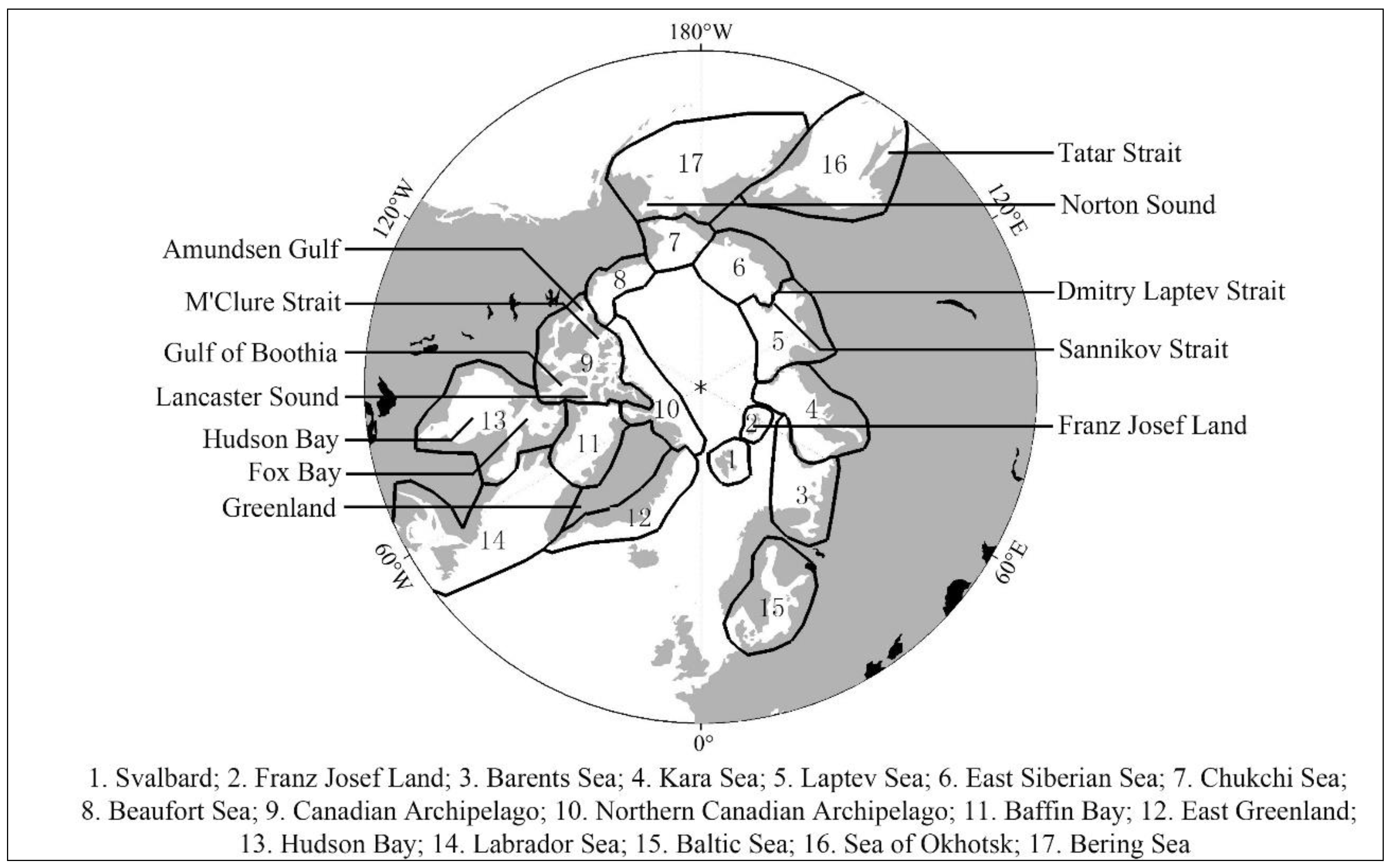
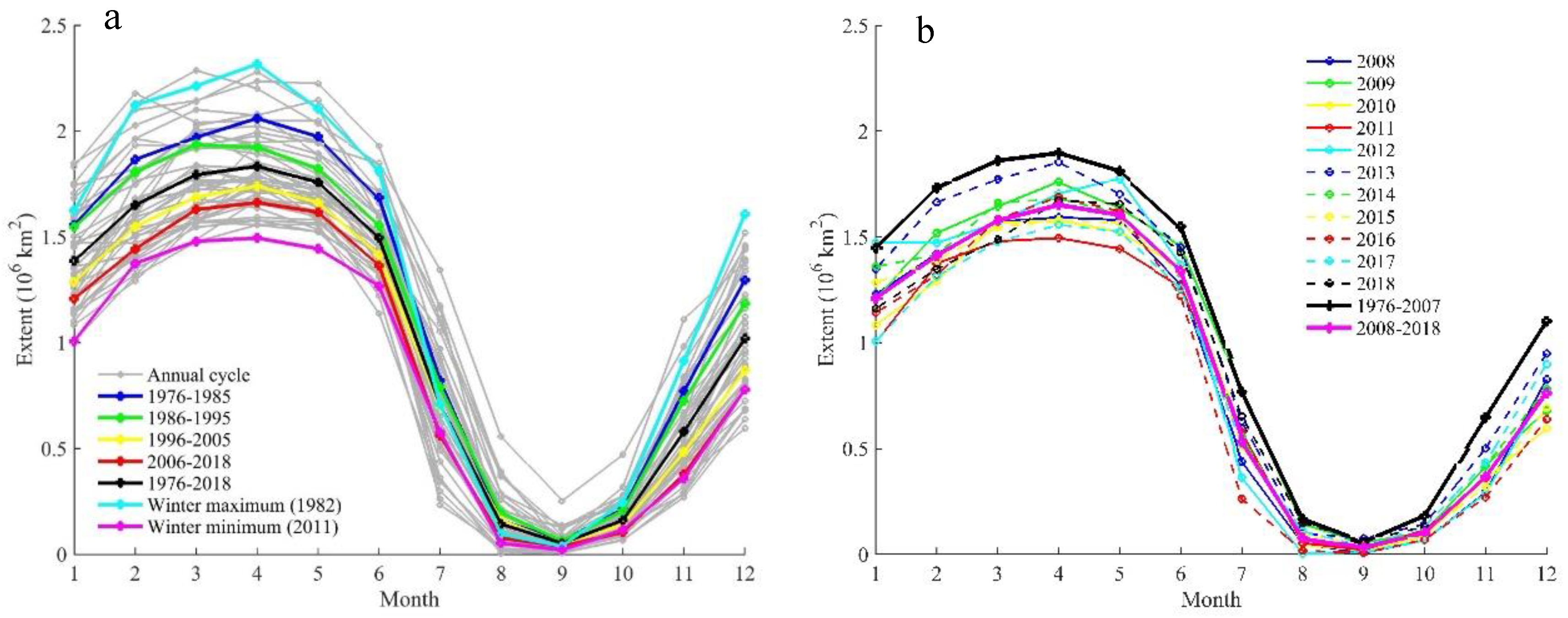
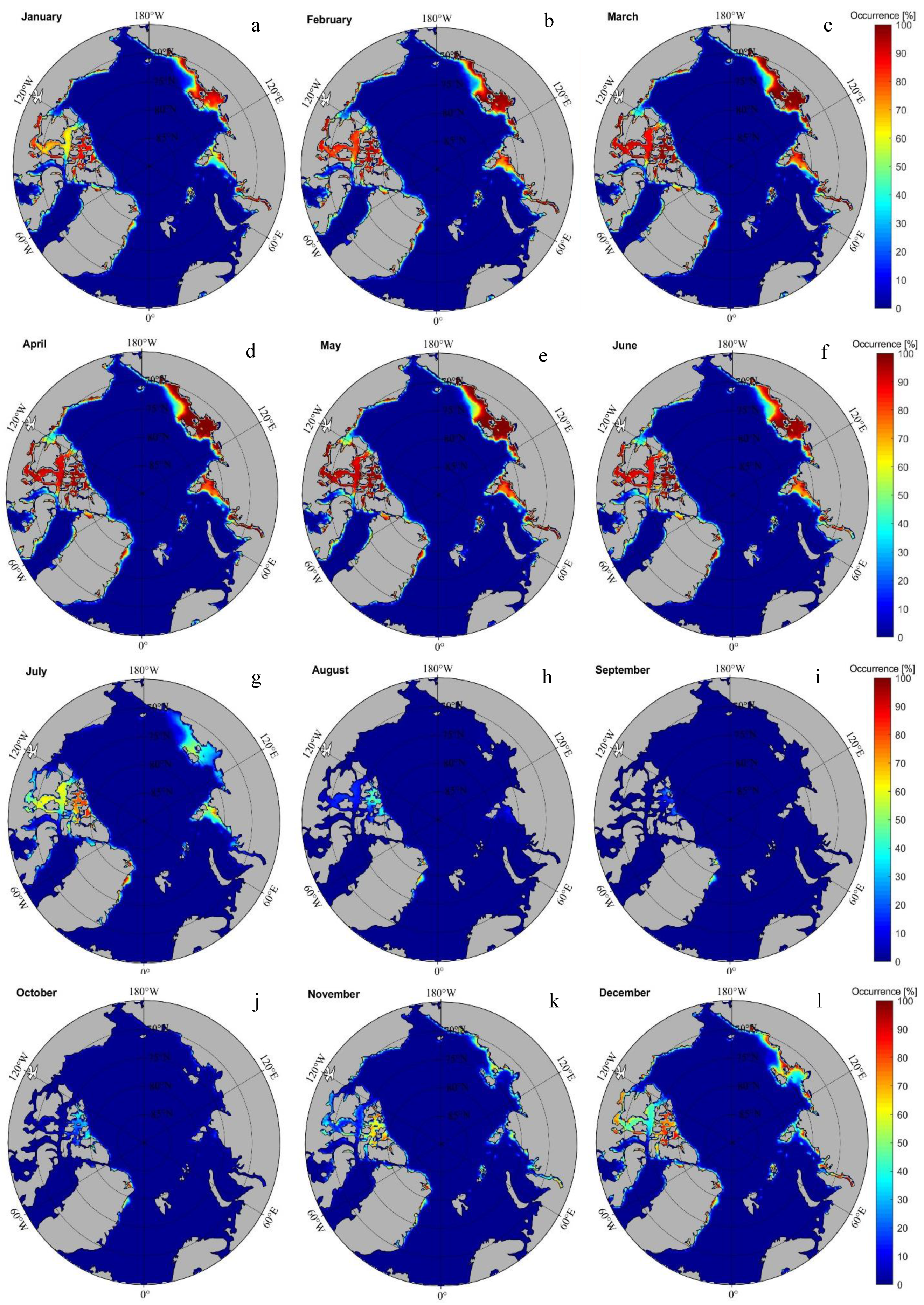
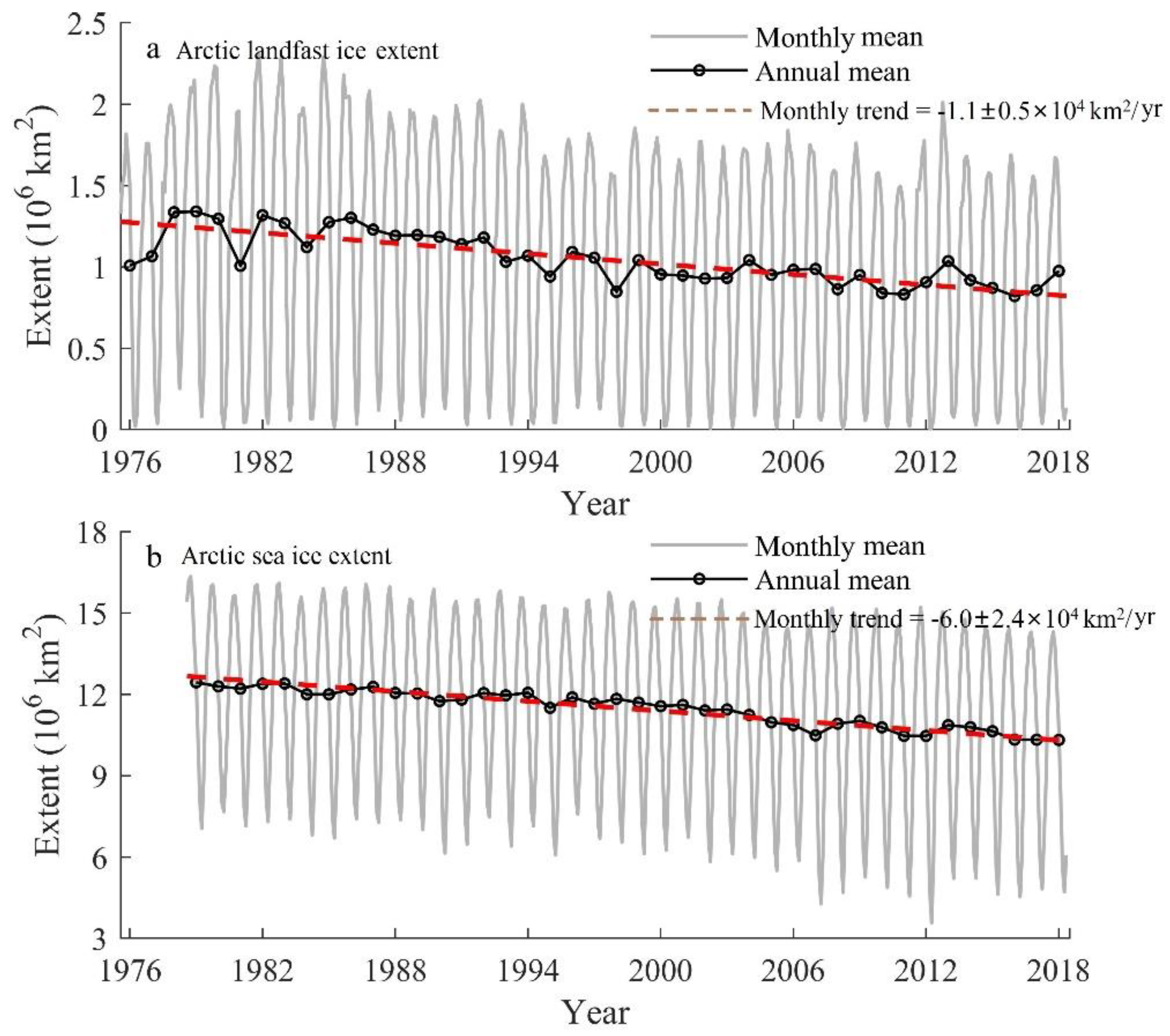
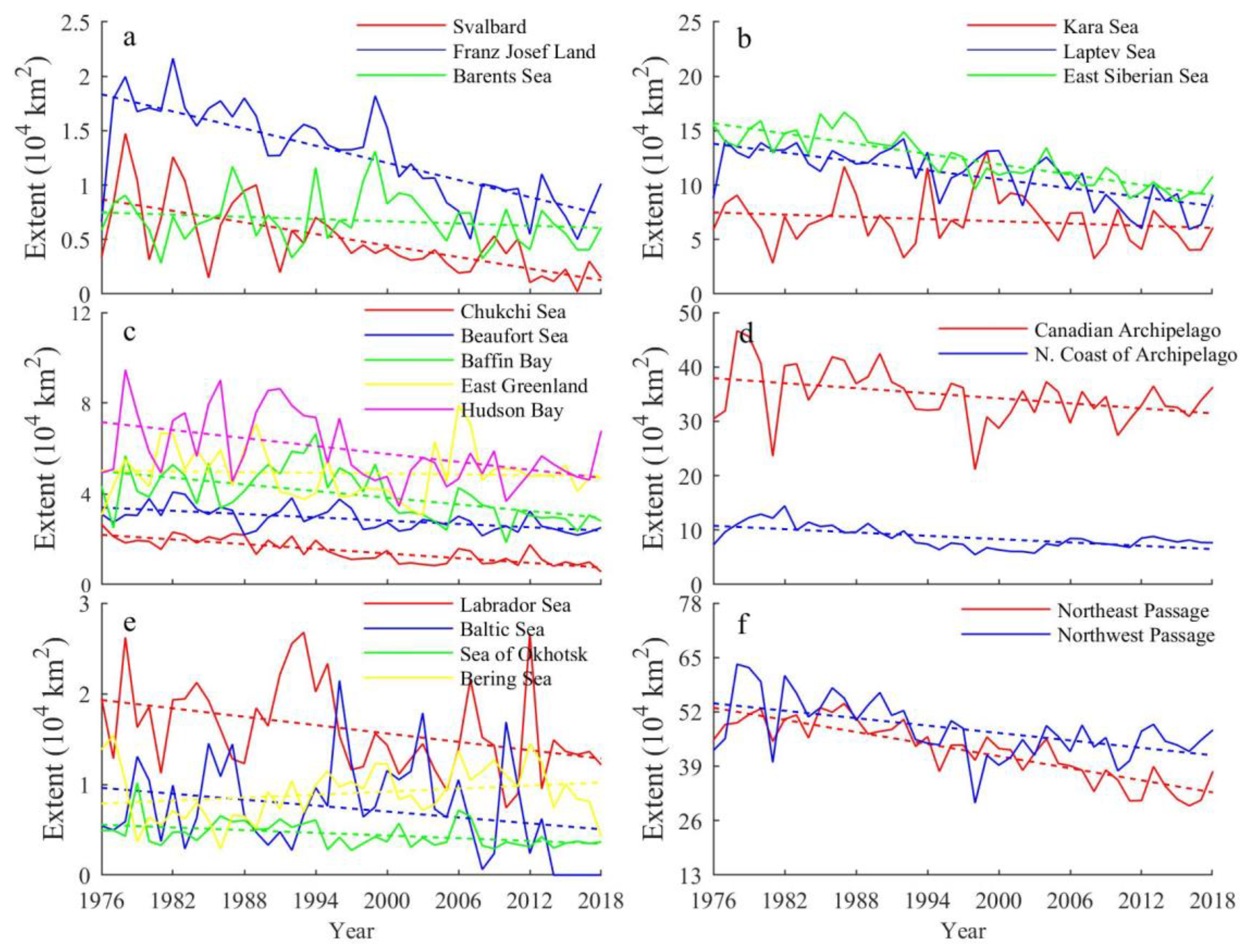


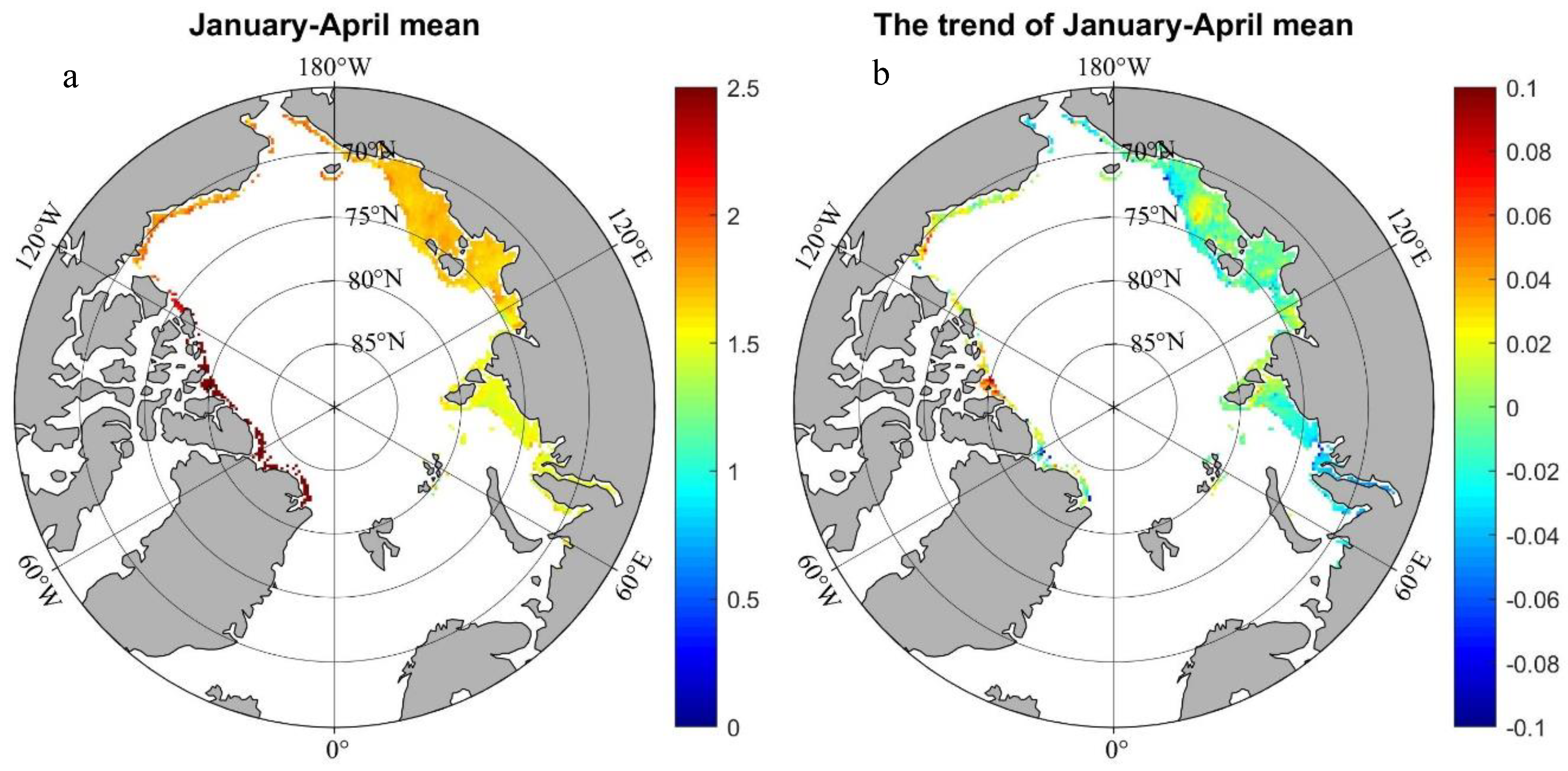


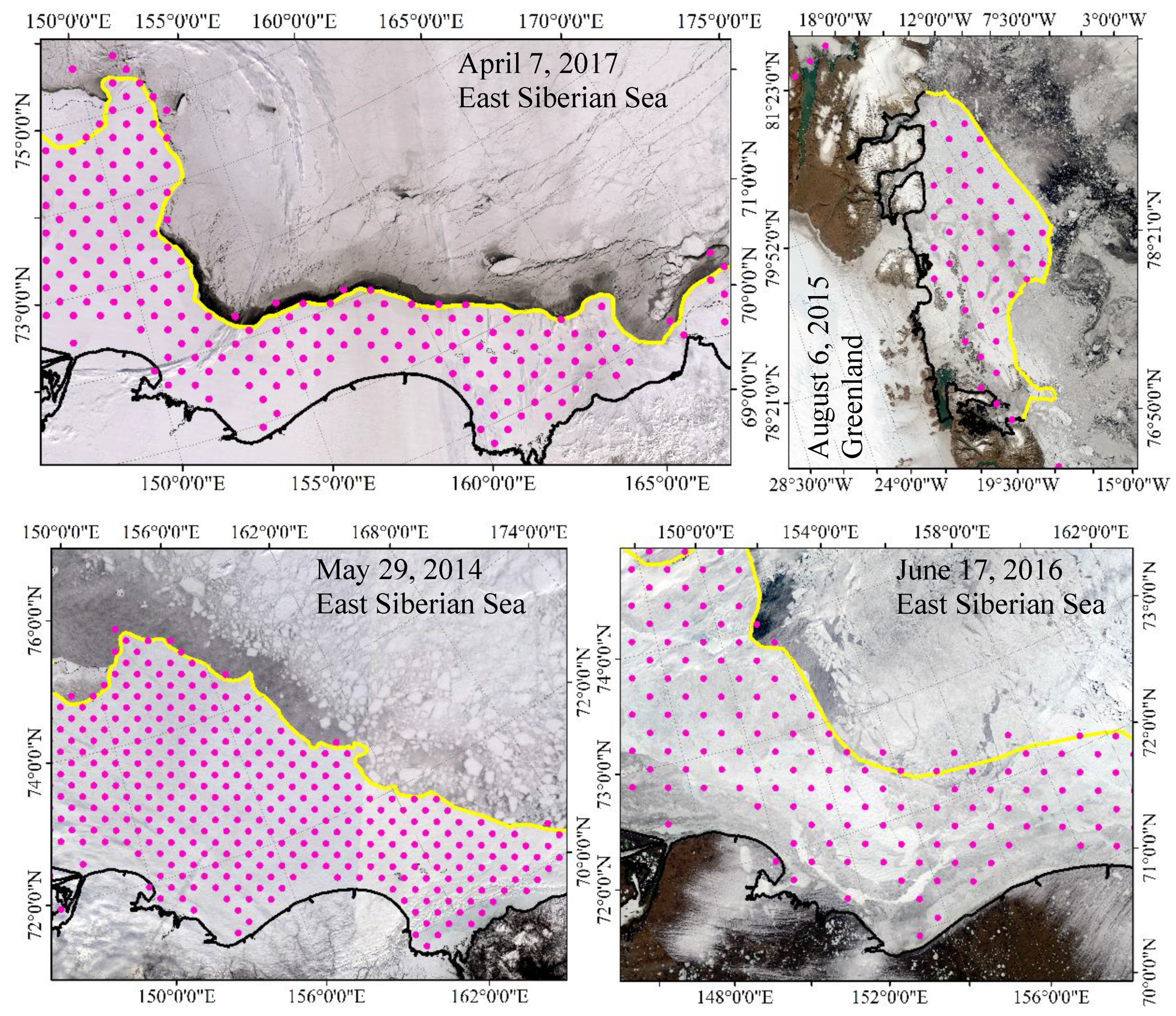
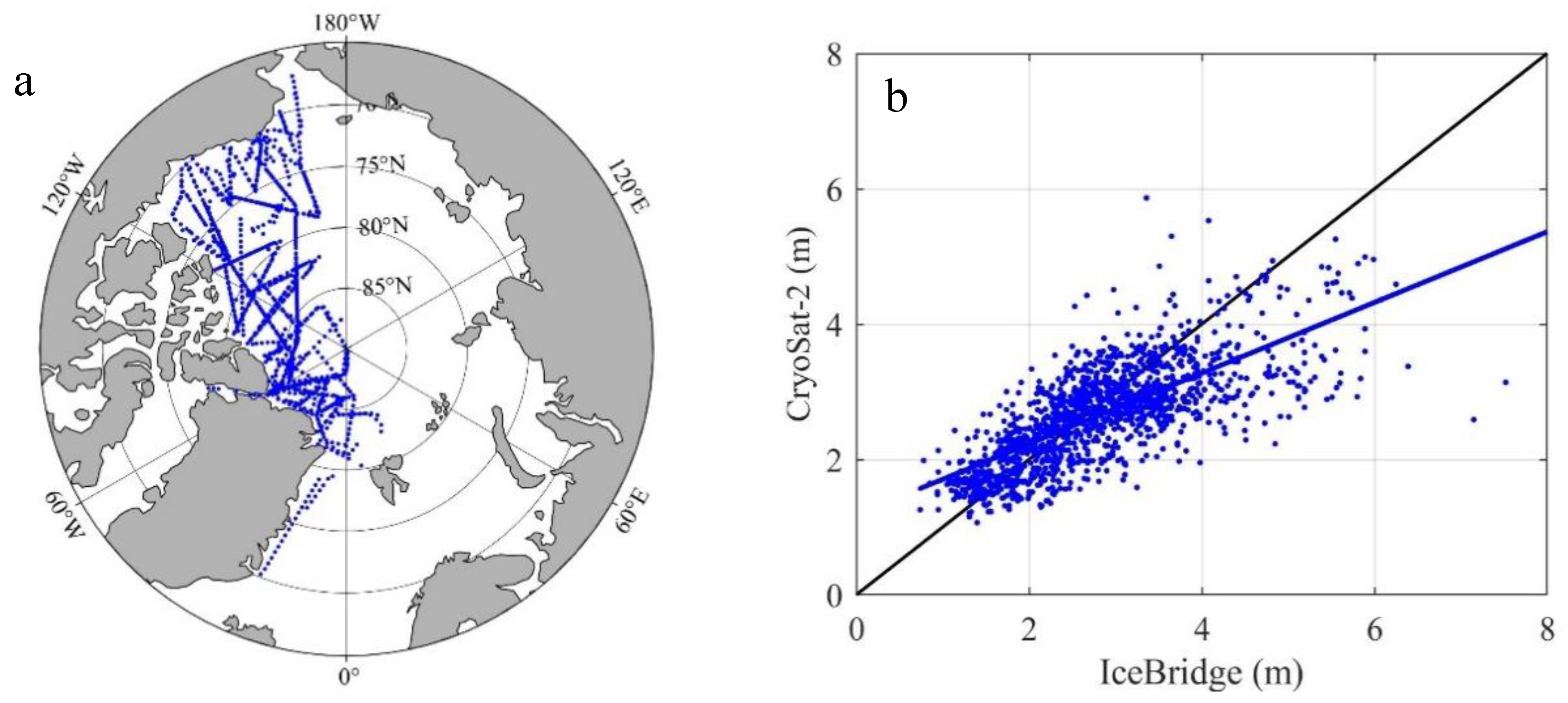
| Month | Mean (103 km2) | Trend (103 km2/yr) | % Decade−1 |
|---|---|---|---|
| Jan | 1386 ± 228.04 | −11.98 ± 4.31 | −8.64 ± 3.11 |
| Feb | 1650 ± 245.49 | −13.79 ± 4.37 | −8.36 ± 2.65 |
| Mar | 1794 ± 218.70 | −11.42 ± 4.15 | −6.37 ± 2.31 |
| Apr | 1833 ± 202.55 | −12.05 ± 3.38 | −6.57 ± 1.84 |
| May | 1758 ± 189.59 | −10.79 ± 3.33 | −6.14 ± 1.89 |
| Jun | 1495 ± 183.79 | −10 ± 3.37 | −6.69 ± 2.25 |
| Jul | 708 ± 261.44 | −9.56 ± 5.84 | −13.50 ± 8.25 |
| Aug | 143.37 ± 118.64 | −3.39 ± 2.78 | −23.65 ± 19.39 |
| Sep | 52.31 ± 46.53 | −1.07 ± 1.12 | −20.45 ± 21.41 |
| Oct | 161.30 ± 80.44 | −3.87 ± 1.61 | −23.99 ± 9.98 |
| Nov | 579.62 ± 212.12 | −13.87 ± 3.3 | −23.93 ± 5.69 |
| Dec | 1020 ± 271.07 | −17.92 ± 4.13 | −17.57 ± 4.05 |
| No. | Subregion | Jan–May Trend in Yu et al. [25] | Jan–May Trend in This Study | Jan–Dec Trend in This Study |
|---|---|---|---|---|
| 1 | Svalbard | −0.28 ± 0.09 | −0.26 ± 0.11 | −0.18 ± 0.05 |
| 2 | Franz Josef Land | −0.19 ± 0.10 | −0.25 ± 0.11 | −0.27 ± 0.07 |
| 3 | Barents Sea | 0.24 ± 0.10 | −0.04 ± 0.12 | −0.04 ± 0.06 |
| 4 | Kara Sea | −0.91 ± 0.49 | −1.91 ± 0.68 | −1.46 ± 0.55 |
| 5 | Laptev Sea | −1.88 ± 0.31 | −1.95 ± 0.39 | −1.70 ± 0.64 |
| 6 | East Siberian Sea | −2.36 ± 0.87 | −2.02 ± 0.46 | −2.03 ± 0.94 |
| 7 | Chukchi Sea | −0.60 ± 0.11 | −0.53 ± 0.14 | −0.37 ± 0.09 |
| 8 | Beaufort Sea | −0.39 ± 0.16 | −0.35 ± 0.20 | −0.27 ± 0.16 |
| 9 | Canadian Archipelago | −2.12 ± 1.14 | −0.96 ± 1.41 | −1.82 ± 1.48 |
| 10 | Northern Canadian Archipelago | −2.48 ± 0.59 | −1.32 ± 0.73 | −1.07 ± 0.29 |
| 11 | Baffin Bay | −0.35 ± 0.33 | −0.77 ± 0.41 | −0.53 ± 0.23 |
| 12 | Greenland Sea | −0.04 ± 0.37 | 0.06 ± 0.44 | −0.09 ± 0.20 |
| 13 | Hudson Bay | −1.34 ± 0.53 | −1.25 ± 0.65 | −0.67 ± 0.42 |
| 14 | Labrador Sea | −0.17 ± 0.17 | −0.26 ± 0.24 | −0.17 ± 0.13 |
| 15 | Baltic Sea | −0.25 ± 0.21 | −0.25 ± 0.30 | −0.12 ± 0.10 |
| 16 | Sea of Okhotsk | 0.11 ± 0.06 | −0.10 ± 0.07 | −0.06 ± 0.04 |
| 17 | Bering Sea | 0.22 ± 0.12 | 0.10 ± 0.15 | 0.03 ± 0.07 |
| Arctic | −12.27 ± 2.71 | −12.01 ± 3.47 | −10.67 ± 4.78 |
| No. | Region | Mean (week) | Trend(Weeks/Decade) (%Decade−1) | F |
|---|---|---|---|---|
| 1 | Svalbard | 34.1 | −2.6 ± 1.9 (−7.7 ± 5.7) | 7.4 |
| 2 | Franz Josef Land | 41.4 | −0.8 ± 1.6 (−2.0 ± 3.9) | 1.1 |
| 3 | Barents Sea | 37.2 | 1.5 ± 1.2 (3.9 ± 3.1) | 6.4 |
| 4 | Kara Sea | 43.1 | −0.2 ± 0.5 (−0.5 ± 1.1) | 1.0 |
| 5 | Laptev Sea | 42.3 | −1.0 ± 0.4 (−2.3 ± 1.0) | 22.4 |
| 6 | East Siberian Sea | 43.1 | −0.9 ± 0.3 (−2.1 ± 0.7) | 39.2 |
| 7 | Chukchi Sea | 42.6 | −1.2 ± 0.5 (−2.7 ± 1.1) | 24.3 |
| 8 | Beaufort Sea | 43.7 | −0.5 ± 0.5 (−1.2 ± 1.1) | 5.0 |
| 9 | Canadian Archipelago | 44.6 | −0.7 ± 0.4 (−1.5 ± 0.9) | 12.3 |
| 10 | N. Canadian Archipelago | 48.4 | −0.0008 ± 0.4 (−0.002 ± 0.009) | 1.6 × 10−5 |
| 11 | Baffin Bay | 41.2 | −1.0 ± 0.6 (−2.5 ± 1.4) | 12.9 |
| 12 | Greenland Sea | 43.7 | −0.5 ± 2.8 (−1.1 ± 6.3) | 0.1 |
| 13 | Hudson Bay | 38.8 | −0.2 ± 0.5 (−0.6 ± 1.3) | 0.9 |
| 14 | Labrador Sea | 37.7 | −0.8 ± 0.5 (−2.1 ± 1.2) | 13.0 |
| 15 | Baltic Sea | 37.3 | 1.7 ± 1.2 (4.7 ± 3.3) | 8.0 |
| 16 | Sea of Okhotsk | 39.1 | −0.1 ± 0.5 (−0.2 ± 1.2) | 0.2 |
| 17 | Bering Sea | 39.5 | 0.4 ± 0.5 (1.1 ± 1.3) | 2.9 |
| Arctic | 44.0 | −0.6 ± 0.3 (−1.4 ± 0.6) | 23.0 |
© 2019 by the authors. Licensee MDPI, Basel, Switzerland. This article is an open access article distributed under the terms and conditions of the Creative Commons Attribution (CC BY) license (http://creativecommons.org/licenses/by/4.0/).
Share and Cite
Li, Z.; Zhao, J.; Su, J.; Li, C.; Cheng, B.; Hui, F.; Yang, Q.; Shi, L. Spatial and Temporal Variations in the Extent and Thickness of Arctic Landfast Ice. Remote Sens. 2020, 12, 64. https://doi.org/10.3390/rs12010064
Li Z, Zhao J, Su J, Li C, Cheng B, Hui F, Yang Q, Shi L. Spatial and Temporal Variations in the Extent and Thickness of Arctic Landfast Ice. Remote Sensing. 2020; 12(1):64. https://doi.org/10.3390/rs12010064
Chicago/Turabian StyleLi, Zixuan, Jiechen Zhao, Jie Su, Chunhua Li, Bin Cheng, Fengming Hui, Qinghua Yang, and Lijuan Shi. 2020. "Spatial and Temporal Variations in the Extent and Thickness of Arctic Landfast Ice" Remote Sensing 12, no. 1: 64. https://doi.org/10.3390/rs12010064
APA StyleLi, Z., Zhao, J., Su, J., Li, C., Cheng, B., Hui, F., Yang, Q., & Shi, L. (2020). Spatial and Temporal Variations in the Extent and Thickness of Arctic Landfast Ice. Remote Sensing, 12(1), 64. https://doi.org/10.3390/rs12010064






